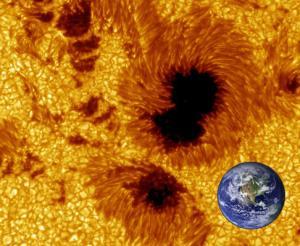Dr. Kenneth Tapping is worried about the sun. Solar activity comes in regular cycles, but the latest one is refusing to start. Sunspots have all but vanished, and activity is suspiciously quiet. The last time this happened was 400 years ago -- and it signaled a solar event known as a "Maunder Minimum," along with the start of what we now call the "Little Ice Age."
Tapping, a solar researcher and project director for Canada's National Research Council, says it may be happening again. Overseeing a giant radio telescope he calls a "stethoscope for the sun," Tapping says, if the pattern doesn't change quickly, the earth is in for some very chilly weather.

|
| A typical sunspot compared to the size of the earth. Sunspots have all but vanished in recent years. |
During the Little Ice Age, global temperatures dropped sharply. New York Harbor froze hard enough to allow people to walk from Manhattan to Staten Island, and in Britain, people reported sighting eskimos paddling canoes off the coast. Glaciers in Norway grew up to 100 meters a year, destroying farms and villages.
But will it happen again?
In 2005, Russian astronomer Khabibullo Abdusamatov predicted the sun would soon peak, triggering a rapid decline in world temperatures. Only last month, the view was echoed by Dr. Oleg Sorokhtin, a fellow of the Russian Academy of Natural Sciences. who advised the world to "stock up on fur coats." Sorokhtin, who calls man's contribution to climate change "a drop in the bucket," predicts the solar minimum to occur by the year 2040, with icy weather lasting till 2100 or beyond.
Observational data seems to support the claims -- or doesn't contradict it, at least. According to data from Britain's Met Office, the earth has cooled very slightly since 1998. The Met Office says global warming "will pick up again shortly." Others aren't so sure.
Researcher Dr. Timothy Patterson, director of the Geoscience Center at Carleton University, shares the concern. Patterson is finding "excellent correlations" between solar fluctuations, a relationship that historically, he says doesn't exist between CO2 and past climate changes. According to Patterson. we shouldn't be surprised by a solar link. "The sun [is] the ultimate source of energy on this planet," he says.
Such research dates back to 1991, when the Danish Meteorological Institute released a study showing that world temperatures over the past several centuries correlated very closely with solar cycles. A 2004 study by the Max Planck Institute found a similar correlation, but concluded the timing was only coincidental, as the solar variance seemed too small to explain temperature changes.
However, researchers at DMI continued to work, eventually discovering what they believe to be the link. The key factor isn't changes in solar output, but rather changes in the sun's magnetosphere A stronger field shields the earth more from cosmic rays, which act as "seeds" for cloud formation. The result is less cloud cover, and a warming planet. When the field weakens, clouds increases, reflecting more light back to space, and the earth cools off.
Recently, lead researcher Henrik Svensmark was able to experimentally verify the link between cosmic rays and cloud formation, in a cloud chamber experiment called "SKY" at the Danish National Space Center. CERN plans a similar experiment this year.
Even NASA's Goddard Institute of Space Studies -- long the nation's most ardent champion of anthropogenic global warming -- is getting in on the act. Drew Shindell, a researcher at GISS, says there are some "interesting relationships we don't fully understand" between solar activity and climate.



Reader Comments
to our Newsletter